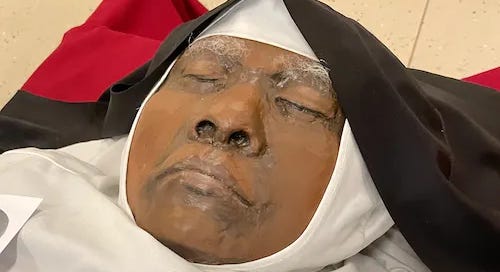
Sr. Wilhelmina’s body ‘lacks any features of decomposition,’ experts conclude
Bishop Johnston released a statement on the former abbess of Gower Abbey after an investigation by a team of medical experts
The Diocese of Kansas City-St. Joseph has released a statement on an investigation into the allegedly incorrupt remains of Sister Wilhelmina Lancaster of Gower Abbey, Missouri. The report concluded that her body lacks “any detected features of decomposition” following her death in 2019.
In a statement released by the diocese, Bishop James V. Johnston said he commissioned a specialist team of medical experts to study the body of Sr. Wilhelmina in May of 2023, led by a doctor of pathology.
“In the final report, the investigative team noted that the condition of Sister Wilhelmina’s body during the examination was notable for a lack of any detected features of decomposition,” the bishop said in a statement released Aug. 22.
“The condition of her body is highly atypical for the interval of nearly four years since her death, especially given the environmental conditions and the findings in associated objects,” the team concluded.
In addition to studying the sister’s exhumed remains, which became a center of pilgrimage for Catholics in the region and across the country last year, the medical team also conducted a series of interviews with witnesses and examined the casket in which she had been buried, as well as the soil conditions at the original gravesite.
While noting that the lining of the casket had deteriorated completely following nearly four years in the ground, the sister’s habit and clothing “showed no features of breakdown,” the experts found. They also reported a lack of any environmental or other external factors which could otherwise account for the highly unusual results.
In April of 2023, her body was exhumed so it could be interred in a planned shrine to St. Joseph in the monastery chapel but was discovered to be remarkably intact, given the passage of years since her death and that she had been buried without embalming of any kind in a simple pine coffin.
Initially the nuns told very few people. They informed diocesan officials, and shared information with some local families and supporters, and waited to see what would happen next.

Many of the monastery’s visitors said the believed Sr. Wilhelmina’s body to be miraculously incorrupt.
The abbey’s superior, Mother Abbess Cecilia Snell, told The Pillar last year that “It is not a common phenomenon to have a body resist decay, especially as there were no natural components to explain it.”
“Sister Wilhelmina's body was not embalmed, nor was there anything to preserve her in the state in which we buried her,” she explained. “There were bugs eating at the foam under her, but none had touched her body or her habit - the latter’s failure to deteriorate being a phenomenon just as miraculous as her intact body!”
“To see her again brought us all a deep sense of hope, a sign that death is truly not the end of our story,” Mother Cecilia said. “Her body points to the resurrection on the last day, but also to life after death, when the soul goes forth to meet Our Lord.”
“She was ready to meet Him, so it stands to reason that that would be reflected in her body, even though it is a rare favor granted to those of us who remain on earth.”
Many visitors to the abbey since the discovery of her intact remains have voiced belief that their preservation is “miraculous,” and noted incorruption after death is a sign often associated with saints.
However, in his statement Thursday, Bishop Johnston noted that “the Catholic Church does not have an official protocol for determining if a deceased person’s body is incorrupt, and incorruptibility is not considered to be an indication of sainthood.”
“There is no current plan to initiate a cause for sainthood for Sister Wilhelmina,” the bishop said, while noting that the lack of any medical explanation for her lack of bodily decomposition “has understandably generated widespread interest and raised important questions.”
The bishop’s note of caution echos a statement from the abbey last year, which said: “While we can attest to Sister’s personal sanctity, we know that incorruptibility is not among the official signs taken by the Church as a miracle for sainthood, and that all things must be subjected to further scrutiny, especially by the competent authorities in the medical field. The life itself and favors received must be established as proof of holiness.”
There is no official list maintained by the Church of incorruptible saints, and no official proclamation is made declaring a saint’s body to be incorruptible.
In De Cadaverum Incorruptione, written in the mid-1800s, Pope Benedict XIV stated that an incorruptible body should only be considered miraculous when its lifelike condition is maintained for a great period of time.












As the foundress of a community that follows...the Old Ways...apparently God loves a "Backwardist!" Huzzah!
This is amazing! Thanks for reporting on this. I hope that Sr. Wilhelmina’s cause for canonization may one day be opened.